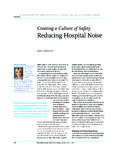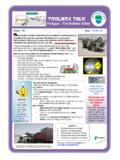Transcription of Abstract - Healing HealthCare Systems
1 AbstractThe patient environment of care plays a vital role in the discipline of patientsafety for every hospital. Demonstratingthat the hospital is a safe place forpatients and for those that work thereshould be of the utmost importance for all health care personnel. This whitepaper outlines 5 important steps that will improve overall hospital safety andincrease patient 1 8/27/10 10:51 AM Page 1 Patient safety is dependent upon both the caregiverand the environment in which care is (and their families) look for visible, palpable evidence that demonstrates that a hospital is a safehaven and that those who care for them are skilled,involved, and, ultimately, will protect them.
2 In theirstate of acuity, patients see and hear everything in relationship to themselves, looking and listening forsigns and symbols that will offer hope and security as they navigate through the HealthCare crisis. Therefore, the environment of care can play a key rolein providing appropriate visual and audio safety cues. To a degree, the intention to promote safety is obviousand commonly visible. Common examples include thesign in the bathroom that reminds the staff to washtheir hands, and the orange skull and crossboneswarning on the stainless steel dirty needle container in every patient room.
3 Furthermore, the nurse call button confirms that someone is within reach; the barsin the bathroom and along the corridors say that allefforts have been made to prevent patients fromfalling. Caregivers wearing gloves is another safety indicator. While these are ways of standardizing safety,the question remains as to why hospitals continuallyconfront the unfortunate reality that they are notalways safe nor perceived as RisksJCAHO identifies noise as a potential risk factor relatedto medical and nursing errors, stating that the ambientsound environments should not exceed the level thatwould prohibit clinicians from clearly understandingeach other.
4 An article in the Journal of the Associationof Operating Room Nurses (November, 2003) reporteda surgical episode in which the music was so loud thatthe surgeon's directions to the anesthesiologist regardingheparin levels were misunderstood by 8,000 , beyond annoyance, within the sound environmentlie potential safety risks that are often unidentified orignored. (Mazer, 2003) Clemenceau Medical Center, a facility in Beirut,Lebanon, managed by Johns Hopkins, designed theirfacility to be inherently safe and of the highest quality,believing that one cannot exist without the Fakih, Director of Engineering, defines activefailures as those made by provider error.
5 He defineslatent conditions as conditions present in the system or environment that contribute to the errors made. Mr. Fakih includes the following in his list of latent conditions: (1) poor facility design, (2) poor patient visibility and high noise levels, (3) lack of standardization, (4) excessivepatient movement, and (5) inappropriate or complexprocesses. (Fakih, 2006) What all of these conditions have in common is thatthey exist in the day-to-day environment . Habituationand complacency are the greatest contributing threats to both patients and staff. As Florence Nightingale stated,the sick room itself will interact with the disease andcause harm to the patient (Nightingale, 1860).
6 The environment of care can become the place where safety is, itself, at risk. Promoting patient safety from an environmental stand-point requires active attention to the daily circumstancesthat increase risks to both patients and Steps to Improve Patient SafetyHere are five steps that will improve overall hospitalsafety and lead to increasing patient satisfaction: stored equipment from public areas:A common practice in hospitals is to make hallways a storage area for equipment in waiting. Risks can behigh when unforeseen situations happen, such aswhen a visitor trips over a cart wheel that is protrudinginto the walkway, or a rushing staff member hurriedlycomes around a corner, falling due to IV poles andmonitors left in the pathway.
7 Ways to Improve Patient Safety: How the environment Plays a Critical RoleBy Susan E. Mazer, MAPresident and CEO, Healing HealthCare Systems , 1 8/27/10 10:51 AM Page 1If there is no alternative, only minimum equipmentneeded should be tolerated. Good planning and acommitment to safety must drive creative and effectivestorage options that are far safer than hallways. hospital room clutter:In her Notes onNursing (1860),Florence Nightingale said that nothingin the patient s room should prevent the nurse fromseeing dust and dirt for fear of insidious the hospital room, this means keeping clutter away,properly storing or removing clothing, meals trays, andbasically everything not immediately needed or beingused.
8 Maintaining a clean and un-encumbered patientroom is essential to keep the patient safe . Clean in thiscase is not only about cleaning, but, as stated, involvesputting away or removing those things that are notserving the immediate patient needs. This may be chal-lenging but should be mandatory. Patients and familieswill appreciate the need for keeping the room safe andwill participate in order to minimize preventable risk. or organize area clutter:Nursing stationsmust be well managed so that everything that needs tobe seen can be seen. Cluttered desks are layered, oftenwith both essential and non-essential items; if there arelayers, much of what is there cannot be seen.
9 Organizethe paperwork so that it can be found, but don t let pilesof records hide themselves in plain view of everyone in the confidentiality of individual medical records isthreatened when desks are piled high with patientrecords or other overall cleanliness of all areas: What iscluttered does not look clean; what is not clean, lookscluttered. A study in the UK showed hospitals that wereperceived to be unclean had a 10% higher rate of infec-tion. Perception confirms the otherwise invisible in carpets, privacy curtains, unkempt bathrooms,lingering meal trays and housekeeping carts tell a tale ofsloppiness that cannot be tolerated.
10 This includes publicbathrooms as well as patient toileting areas. auditory clutter: Considering unnecessarynoise as auditory clutter puts into perspective the risksfor patients and staff. Ambient noise in the hospital,regardless of source, has been associated with every-thing from sleep deprivation to medication errors, frompatient falls to breaches in confidentiality. Because thegeneral noise occurs in the same frequency range as the spoken voice, it is easy for words to be drugs and sound-alike instructions spoken intoa sea of babble, invite errors and subsequent mistakes inpractice.






